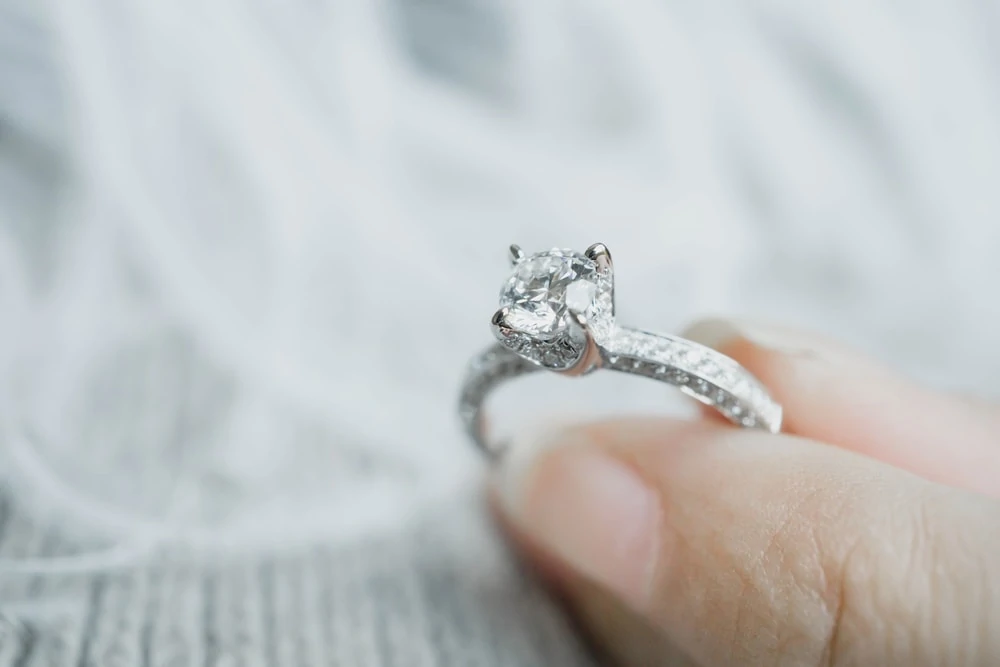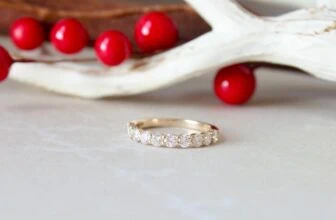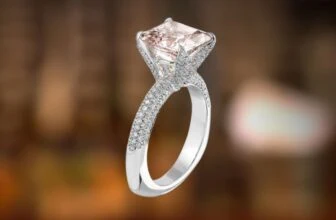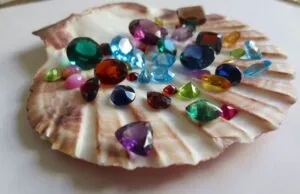
Table of Contents
Emerald cut diamonds are the most popular of the step cuts. While they don’t have the same sparkle as a brilliant cut, emerald cut diamonds have an elegance and depth unmatched by other cuts.
But there’s no point buying the best emerald cut diamond without choosing the best ring setting to highlight its beauty while keeping it secure. And not every ring setting will look good paired with an emerald cut.
Let’s take a look at 3 of the best emerald cut diamond settings and why they work so well with this particular cut.
1. Prong Setting
Pros of Prong Setting
- The diamond is highlighted and enhanced
- Light reflection is maximized
- Enhances the size of the diamond
- Diamond is secure
- Easy to clean and maintain
Cons of Prong Setting
- Prongs can catch on every day objects
- Over time, prongs can wear out
- There is a risk of the diamond getting loose, knocked or damaged
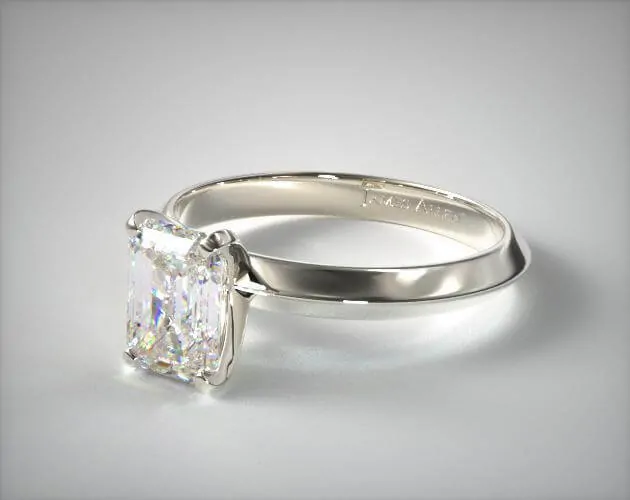
Prong settings are most couple’s favorite option for engagement rings and the go-to choice when it comes to settings. It makes the diamond appear large as it is the focus of the setting.
Set the diamond with a thin band and you can emphasize its size even more. Prongs don’t obstruct the view of the diamond, allowing the stone to be clearly seen.
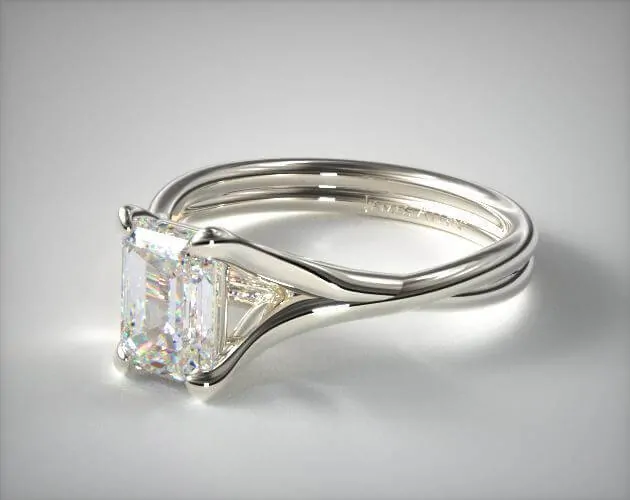
Emerald cut diamonds aren’t brilliant. Rather, their beauty lies in the contrast of light and shadow, creating a ‘hall of mirrors’ effect. The prong setting maximizes this effect, allowing optimum light reflection. The light allows for the contrast between dark and light in the steps to show, adding depth and dimension to the diamond.
While most emerald cut diamonds are set with 4 prongs, holding the corners firmly, it’s best to opt for 6 or 8 prongs for larger diamonds. This ensures that the stone is held securely without the danger of it falling out.
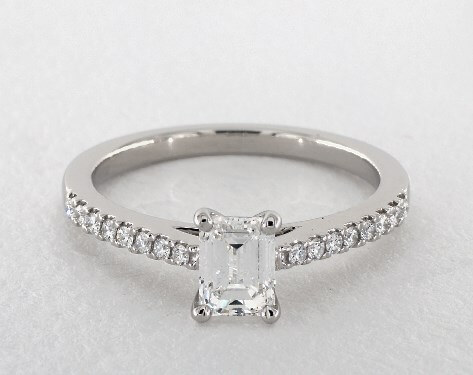
As with all settings, prong settings require maintenance and periodic inspection to ensure that the prongs are still strong and in place. Over time, they can wear thin and impact can bend or even break the prong, putting the diamond (or gemstone) in danger of falling out. Another danger is that because the diamond is so exposed, there is the risk of the diamond getting hit or knocked, which can damage the stone.
2. Halo Setting for Emerald Cut Diamond
Pros of Halo Setting
- The center stone is highlighted
- Added brilliance and sparkle
- Makes the diamond appear large
- Offers protection from impact
- Cost effective
Cons of Halo Setting
- Cleaning can be difficult
- Small diamonds may fall out over time
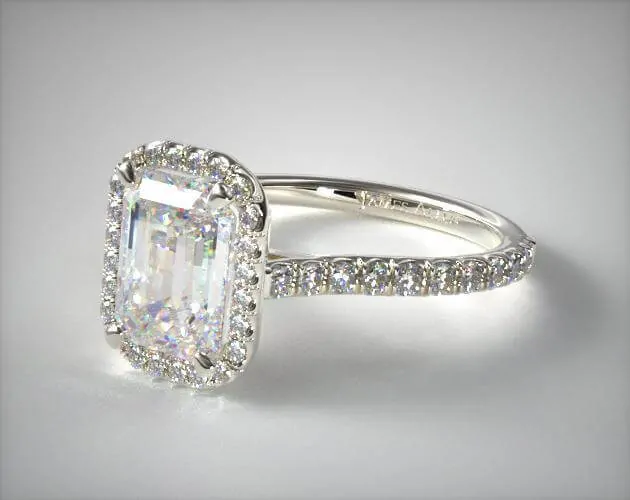
Halos are commonly created by placing a ring of tiny diamonds all around the center stone. Halo settings are stunning for emerald cut gemstones. They add that extra touch of sparkle that the emerald cut lacks, creating a surrounding sparkle that emphasizes the unique beauty of the emerald cut, all the while keeping the focus on the center stone.
One of the main advantages of the halo is that you can opt for a smaller center stone and still have it appear large when surrounded by the halo. Our eyes tend to measure the size of the center diamond from edge to edge of the halo rather than from the edges of the diamond. What this translates to is that you can save money by purchasing a smaller emerald cut diamond.

Halo settings tend to provide more protection for emerald cuts than prong settings, as they create a buffer around the diamond. Unless your diamond is hit dead center, the halo will protect it.
If you’re feeling bold, you can opt to have a surrounding of tiny colored gemstones or colored diamonds to add color and character to your ring. Note that colored gemstones will not have the same depth of sparkle that diamonds have.
3. Three Stone Setting for Emerald Cut Diamond
Pros of Three Stone Ring
- Endless opportunities for customization
- Smaller diamonds can be used
- Meaningful symbolism
- Coverage for wider fingers
Cons of Three Stone Ring
- Harder to clean and maintain than simpler settings

There are many variations to the three stone setting, which means that whether you are a minimalist or a maximalist, there is bound to be a three-stone ring design that you’ll love.
You can opt for three equal-sized emerald cut diamonds set side by side or you can choose to have different gemstones in varying sizes.
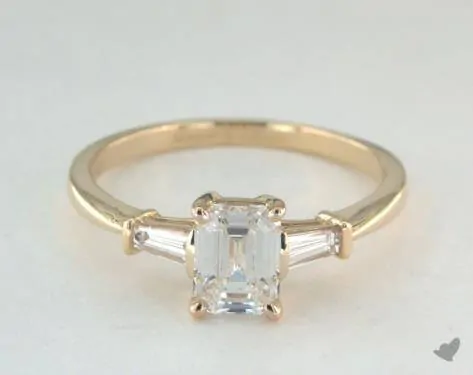
Another variation is to mix and match different diamond cuts. The example below shows an emerald cut flanked by two tapering diamonds.
The three-stone ring design allows you to utilize smaller diamonds, cutting the cost of your diamonds.
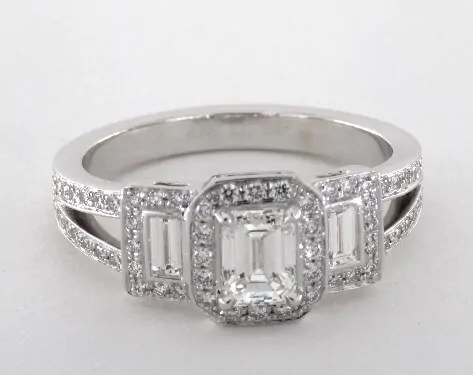
For ladies with wider fingers, three-stone rings offer great coverage and fit the hand perfectly. You can never have too many emerald cut diamonds, so setting them side by side is simply beautiful and eye-catching. The three-stone emerald engagement ring proves that a diamond doesn’t have to be brilliant to be gorgeous!
What About Other Settings?
The emerald cut lends itself well to most engagement ring settings that choosing the right one will be fairly easy. In general, variations of the prong, halo and side-stone setting make up most of the types of settings.
One setting that you may wish to avoid is the bezel setting, as it minimizes the size of the diamond and does not add to its luster. For an emerald cut diamond, the bezel can actually make it appear underwhelming.
However, some people love the sleek, contemporary look of a bezel set emerald cut diamond, so go with your gut feeling. If you like how it looks, then there’s no reason you shouldn’t opt for it!
Before you decide on your setting, consider your lifestyle, style and preferences to find the setting that offers you the degree of protection you require for the emerald cut diamond.
Where to Buy Emerald Engagement Rings
There are many excellent places to purchase a emerald cut diamonds online, be it a loose diamond or a pre-set engagement ring.
Whichever retailer you decide to go with, always make sure that they are reputable, are specialized in what they do and will provide you with certification.
We prefer GIA-certified diamonds, as the lab is known for its stringent quality parameters when assessing diamonds.
We recommend the following retailers:
Why: Superior diamond imaging, competitive prices, high quality, wide range
An online giant in the diamond space, James Allen a stunning collection of high-quality diamonds and gorgeous ring settings. The images and videos are unparalleled in quality and makes shopping online similar, if not better, to shopping in store.
Why: Competitive prices, wide range, great quality
Known for dominating the online diamond industry since the late 1990s, Blue Nile offers one of the largest online diamond inventories. Search diamonds and settings here at competitive prices, solid after-sales policies, and good customer service.
Why: Superior cut quality, exclusive range, stunning designs
Whiteflash has earned an international reputation for the elite quality of their precision cut diamonds, and for their impeccable collection of designer engagement rings. Check their stunning range of diamond jewelry and loose diamonds.
Why: Impeccable quality, superior cut, small but exclusive inventory
Brian Gavin is a renowned expert in diamond cut – and it shows in their superior diamond quality. For the very best in diamonds, search their inventory of designer diamond jewelry and loose diamonds.
Why: Try before you buy, build your own ring, great quality
If you want to try out how a round diamond ring looks on your finger before you commit to buying one, check out With Clarity’s Home Preview Service which is completely free. Find out more here.
Check out our quick comparison of the top online engagement ring retailers for more information.
Wrapping Up
Emerald cut diamonds are an excellent option for a diamond ring that’s different the what’s commonly chosen. The brilliance is subdued in these diamonds, but they’re as classy and elegant as any more expensive diamond cut. Pair your emerald cut diamond with the right setting to maximize its beauty.


